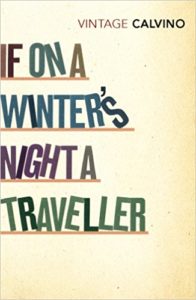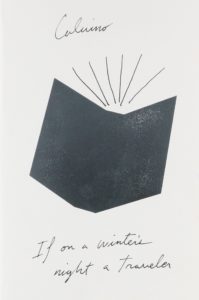

What makes lovemaking and reading resemble each other most is that within both of them times and spaces open, different from measurable time and space.
*
“Calvino is a wizard. His last work of fiction, The Castle of Crossed Destinies, was inspired by two packs of tarot cards. The hero of the latest work is ‘the new Calvino’—in other words, itself. The novel the reader has opened is the same novel a Reader inside the cover has gone to a bookstore to procure, having seen an item in a news-paper announcing that a book by this author, the first in several years, has appeared. Everything fairly normal so far. Calvino’s Reader—the one inside the story—is a reasonable updating of the “dear reader” of the old fictioneers. As one might expect, relations have become more informal, to the point of getting familiar: right away the author is calling him ‘You’ (‘tu,’ ‘ti,’ ‘te,’ in the original). which is like getting on a firstname basis at the first handshake. ‘Calvino,’ a hospitable figure, is concerned that the new owner of his book should have optimum conditions for the enjoyment of it: good light, a comfortable position, no distractions (‘No, I don’t want to watch TV!’), cigarettes and an ashtray if he smokes.
What may strike the reader (small r, you or me, not Him) as possibly a bit odd is the insistence on the Reader’s anticipation, as though this were an arsamoris and the whole first chapter, in which we meet author and reader but not yet the book, were the foreplay, stimulation of erectile tissue prior to the act of reading as recommended by a rather permissive sex manual. The Reader is instructed to ‘Relax,’ ‘Concentrate’; we watch him, alone at last with the desired object, sensuously postpone his pleasure, turning the volume over in his hands, glancing through the jacket copy, while the author, also watching, approves, up to a point: ‘Of course, this circling of the book,…this reading around it before reading inside it, is a part of the pleasure,…but like all preliminary pleasures, it has its optimum duration if you want it to serve as a thrust toward the more substantial pleasure of the consummation of the act, namely the reading of the book.’ This should be a hint of what is to follow: consummation withheld—a series of beginnings, ten to be exact, ten novels that break off just as they are getting interesting, ten cunningly regulated instances of coitus interruptus in the art and practice of fiction.

“From the start, from the very first lines, like a barely heard alarm-bell, ‘the new Calvino’ induces slight anxiety in the Reader preparing himself to recognize the ‘unmistakable tone’ of the author—one of the small initial sensations, highly pleasurable, of opening a volume by an author one already knows. But now the awaited sensation fails to materialize: this new one does not read like a Calvino. There seems to be no connection with any of his others. Nonetheless the Reader persists, swallowing his first disappointment. In one who is hooked on the potent old drug, the urge to read is greater than the urge to read a Calvino.
In fact, as our marvelous storyteller fully demonstrates, the addict can no longer be choosy; we behold him at the mercy of his habit, suffering withdrawal symptoms when the supply is abruptly cut off, unable to break himself of the solitary practice, so easily fallen into, of letting his eyes run from left to right, then right to left on a swift diagonal, dropping down a line, and again left to right, back and forth across any bound sheets of printed white paper so long as order and serial pagination have been respected

“As my reader has surely heard if he is tuned in to literary events, If on a winter’s night a traveler keeps turning into other novels, into, finally, nine successive polymorphs that break off at the point where the reader starts to feel real suspense as to what will happen next, the point where in an old movie serial the heroine is tied to the railroad tracks and the engine is coming steadily toward the viewer, who has to wait patiently for next week’s installment not to be sure of the worst. Ten short cliff-hangers (though in some cases the drop is modest), ten contemporary authors (counting the false Calvino), ten titles, ten manners somehow familiar to the ear but by no means parodistic.

“In general, though, what we are offered is ten volatile distillations of the novelistic essence bottled in ten diverse scent-containers. The little narratives are evocative in the same way as the white butterfly that flies across the valley from the book page the young woman is reading to alight on the page Silas Flannery is writing. What makes the white butterfly so poignant? What does it evoke? Literature, I suppose, because it is softly telling us that it is an author’s device, a symbol; we are given an almost stolen glimpse of the author putting in a symbol. But, beyond symbolizing a symbol, it also evokes the errant, fluttery nature of communication, the perishability of message and messenger (it is an ephemerid), and conceivably the old lepidopterist, Nabokov, still haunting the Swiss peaks and valleys where he spent his last years, yet if there is such an allusion it is less an omaggio dell’autore than a smiling acknowledgment of a presence.
A presence that in my opinion is wrongly evoked in connection with Italo Calvino, even though I have just been guilty of doing so, led on by the white butterfly. In the first place, I cannot escape the feeling that Calvino is no admirer of Nabokov, who likes to treat the reader as an adversary in a one-way hide-and-seek game. In the second place, I can see no influences at all at work on ‘the new Calvino,’ even of writers he has quoted admiringly in his critical prose, no literary genetic imprint, no trace of Borges, for example; if there is a hereditary line to be found, it winds back, surely, to the Orient, where all tales come from.

“It is better than a parade. It is a Summa fictionis of scholastic rigor and, like all glorious codifications of divine mysteries, it has to do with love. The act of reading, when finally consummated, is seen to be parallel to the act of love. And at the same time, lest the foregoing seem too awesome for a book so sweet-natured and shyly merry, there is something here suggestive of an old-fashioned small-town garage (maybe an old Fiat place) with a car inside that has the hood up and a jack or so underneath. An inventor in a white coat, the top mechanic, is lovingly tinkering with it, tuning the engine and listening like a doctor. Just about every part of it is worn out and begging for replacement. It is a lovely piece of junk. And yet when the inventor shuts down the hood and takes his place at the wheel of the contraption, removing his white coat (or maybe he is wearing a white short-sleeved jump suit), it actually moves, responding to the slightest touch of the accelerator pedal. And what does it run on? I think that must be suspense, an organic natural product that nobody, not even (so far) our inventor, can tell us much about. If I can try to read his mind, I guess that written down there is the idea that it has some connection with sex.”
–Mary McCarthy, The New York Review of Books, June 25, 1981

